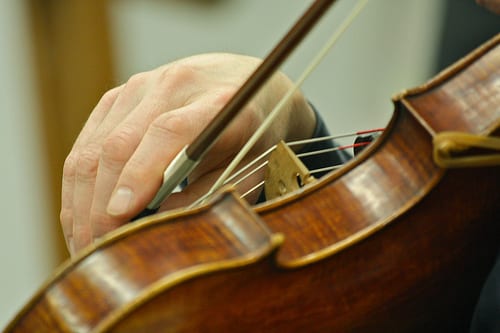 Selecting a violin bow, much like choosing a guitar, can be a very subjective process. To the uninitiated, it’s “just a violin bow.” They’re all the same, right? Wrong. To the seasoned violinist, the perfect bow will depend on the player’s technique, playing style and overall personal preference. There are several factors that can affect the sound of the bow on the strings, including strength, shape, and age of the bow.
Selecting a violin bow, much like choosing a guitar, can be a very subjective process. To the uninitiated, it’s “just a violin bow.” They’re all the same, right? Wrong. To the seasoned violinist, the perfect bow will depend on the player’s technique, playing style and overall personal preference. There are several factors that can affect the sound of the bow on the strings, including strength, shape, and age of the bow.
Most beginner violins come with bows that are perfectly fine, but as you progress in your playing, selecting a better bow can make a huge difference. It may take some time to select the perfect one, but the process is well worth it.
Your violin teacher will be able to give you pointers and suggestions to help you choose a good bow, so speak with him or her if you’re thinking about upgrading your bow. Read on to learn about a few of the details that you and your teacher should consider, as noted on All Things Strings:
1. Type of Material: Choices include Brazilwood (prices usually seen between $50 and $200), Pernambuco (priced anywhere from $100 to $10,000 or more), carbon fiber (priced anywhere between $50 and several thousand dollars) and fiberglass (usually the lowest-priced option).
2. Sound: Look for a bow that will give both a smooth, broad sound and at the same time possesses great clarity of focus and the quickness of response that comes from a stronger, stiffer bow.
3. Weight and Balance: Look for a bow that feels right in your hand. To test the weight, pick up a bow and hold it at a 45-degree angle. It should feel natural in the hand – well balanced from tip to frog with equal weight throughout.
4. Shape: Round or octagonal? With two bows made from the same wood, the octagonal shaft will be stiffer. Some octagonal bows are quite stiff, creating a hard, one-dimensional tone. Some of the German commercial-bow producers make round and octagonal versions of the same bow, the octagonal being a bit more expensive. This has added to the myth that octagonal bows are better.
You’ll want to bring your own bow and instrument along when you’re shopping, because each bow may perform differently. The overall goal here is to find the bow that best compliments your violin. As you try out each bow, you’ll start noticing the differences.
Need help finding a violin teacher in your area? Click here to browse teacher profiles near you! Like these posts? Sign up to receive daily updates right to your inbox! Click here to subscribe.
Suzy S.
